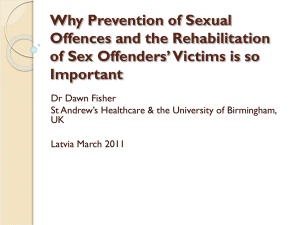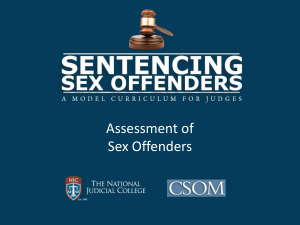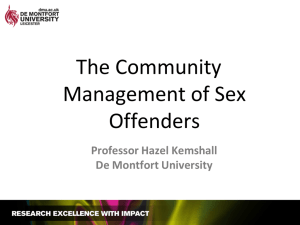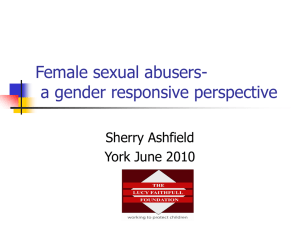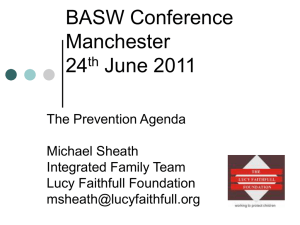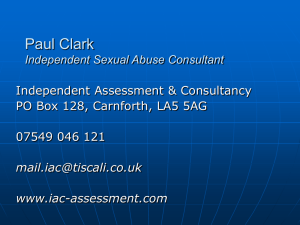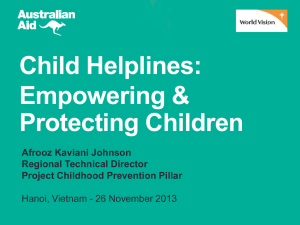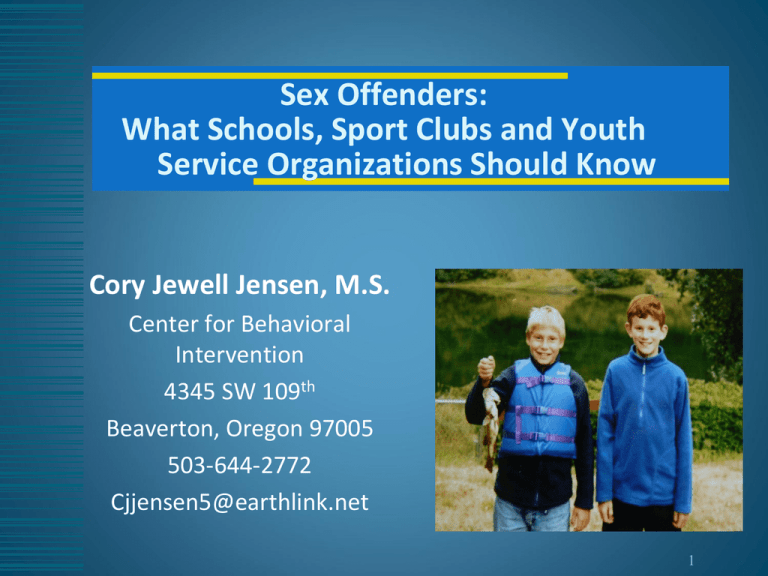
Sex Offenders:
What Schools, Sport Clubs and Youth
Service Organizations Should Know
Cory Jewell Jensen, M.S.
Center for Behavioral
Intervention
4345 SW 109th
Beaverton, Oregon 97005
503-644-2772
Cjjensen5@earthlink.net
1
Studying Criminals to
Safeguard Children
Training originally designed for LEA
Disturbing information
Sit through it once in your careerr.
Only one of the many problems facing children,
families, schools and youth organizations
If you are a parent, thing about the information for
a while before you talk to your children!
If you have a history of abuse, talk to
someone afterward.
2
Sex Abuse/Misconduct Problems
That Impact All
Child Serving Institutions
20% of all children and adults have/will be victimized.
Agencies face students/student, staff/student, staff/staff or staff/off
property misconduct.
Can involve hands on crimes, Internet crimes (child pornography or
“travlers”), hands off (peeping/exposing) or harassment.
Victims may have special needs and abuse can interfere with learning.
All can impact children, co-workers and administration
3
Workshop Topics
The “math "of child abuse.
Etiology of sexual deviancy.
Reporting, detection rates, “cross over”
Offender “MO,” or “Grooming” Tactics
Red flag behaviors to watch for.
Other things we can do to protect children
and agencies.
4
Where Do They Come From?
What causes this?
How do people get this way?
Are we raising more?
5
Polygraph Testing Leads to Better
Understanding of Adult and Juvenile Sex
Offenders (Hindman, J. & Peters, J., 2001)
Adult Offenders
Ave. # of
Victims
Sexually Abused
As Child
Sexually Abusing
As Child
Pre-polygraph
Post-polygraph
2.9
11.6
61%
30%
27%
76%
6
The Offender’s View
“As a small child, I had a 4-year-old sexual friend with whom I enjoyed
many childhood sexual experiences. Our friendship lasted four or five
years and my victims reminded me of my childhood friend. “
“I can’t even remember a time when I wasn’t sexual with other
children.”
“I developed a sexual interest in young girls that stayed with me as I
grew older.”
“At I got older, I got better and better at picking victims.
“After I was abused, I became really sexual and it didn’t take much to
trigger my behavior.”
“Once it got started, it snowballed and my parents never even knew
what was happening to me.”
7
Children and Problematic
Sexual Behavior
Experts estimate that 1 in 10 children engage in
inappropriate sexual behavior with other children.
35% to 40% of all sexual crimes against children
are committed by juveniles.
40% of “acquaintance rapes” are committed
by juveniles
Adult offenders report that the average age of
their first criminal sex offense was at age 14.
8
“Watching Makes You Hungrier”
Are kids becoming sexualized/pornified
at a younger age?
Are kids more open about sex?
What impact will the cultural shift have?
Changed in sexual norms
Appropriate adult responses to:
Sexting and pornification
Boundaries
9
Pornified: How Pornography is Damaging
our Lives, our Relationships and our
Families. By Pamela Paul, 2005
One in 4 Internet users reported Internet porn use.
Average age of first exposure to Internet porn is 11.
32% of male and 11% of female respondents reported
viewing online porn.
80% of 15 to 17 year olds have had multiple exposures.
Younger adults reported being more likely to have viewed
porn online.
37% of 18 to 24 year olds.
22% of 35 to 54 year olds.
Common Characteristics of
Child Molesters
Deviant arousal or
interests
Over identification
with children
Sex as a coping
strategy.
Narcissism
Criminality
Adverse family
backgrounds
Attachment problems.
Intimacy deficits
Emotional problems
Social competency
problems
Inadequate coping
skills
Poor impulse control.
11
Where do they take place?
Offenses happen in public, on agency property or
at home.
Second only to families, child serving organizations
have the highest rates of offending.
1 in 10 cases takes place on school property or a
park (Bureau of Justice Statistics, 2000).
94% of people arrested have not been arrested
before (New York Sex Offender Management,
2007)
12
Do Criminal Background Checks
Protect Us?
100% / 30% / 30%
(Dept of Justice, 1996)
Only 3% of crimes had
been reported &
prosecuted (Abel, 1986).
52% of offenders reported
that children had told,
people had discovered, but
no one contacted
authorities. (CBI ,1992)
Offenders commit an
average of 119.7 sex
crimes before they are
caught (Weinrott, 1998).
Men who primarily abuse
girls, abuse an average of
12 girls (Hindman &
Peters, 2001, CBI, 1992).
Men who primarily abuse
boys, abuse twice as many
(CBI, 1992).
Sentencing Advisory Council, 2007
14
Sexual Crimes Among Males
Community surveys indicate 5% to 33% of men
have committed at least one act of sexual
aggression (Grotpellier & Elliot, 2002; Koss, 1987;
Lisak & Miller, 2002, Abbey, et al. 2001).
1% to 2% of the adult male population will be
convicted of a sexual crime (California Office of the
Attorney General, 2004; P Marshall, 1997).
In most states, one out of every 100 men are
registered sex offender (CBI, 2011).
Between 5% and 10% of adult males have
molested children (Lewis, 1986 & DOJ, 1997).
15
Increased Availability & Access
=
Increased Risk
Organizations that cater to children and families
attract sex offenders.
Organizations that portray themselves as “safe”
and focus on “goodness” are at increased risk due
to the decreased wariness and surveillance of
members.
16
Why Do They Come with
The Territory?
People who molest children like to
spend time with children.
Some child molesters/pedophiles gravitate
toward volunteer or employment positions that
offer access to children.
People who molest children enjoy children, are
interested in children, know how to work well with
children and appear to care about children.
Offenders feel “safe” in our agencies.
17
Child Sexual Abuse and the Male Monopoly: An
Empirical Exploration of Gender and A Sexual
Interest in Children (Freel, 2003)
Surveyed 183 child
care workers in West
Yorkshire, England
15% of male and 4% of
female child childcare
workers expressed a
sexual interest in children
4% of the men, 2% of the
women would “have sex”
with children if no one
would “find out” and “no
punishment”
18
A comparative study of demographic data
related to intra –and extra-familial child sexual
abusers and professional perpetrators.
(Sullivan & Beech, 2004)
305 adult sex offenders (41 “PP”)
“Professional perpetrators” had higher IQs
Were less likely to be in an intimate adult relationship
or have children of their own.
24% reported exclusive interest in children
15% said they entered career to offend, 41% said “partly”
to offend, 20% “not sure,” 25% did not intend to offend.
41% said they knew they had a reputation among
children for offending.
19
“The Art Teacher”
20-years worth of reprimands
14 year old boys and erections
“I learned to teach this way.”
Couldn’t stop himself.
20
Teachers
2007 API report reviewed disciplinary records
from all 50 states
Between 2001 and 2005, 2,500 teachers were
sanctioned following allegations of sex abuse
Between 4.1% and 21.1% of students have
reported “contact” sexual abuse by a teacher
Translates into 1 in 5 to 1 in 20 .
21
Educator Sexual Misconduct: A
Synthesis of Existing Literature
Commissioned by the U.S. Department of
Education (2004)
Teachers whose job description included “time
alone” with students more likely to be investigated
for sex abuse of students.
Music teachers and coaches were three times
more likely to be investigated than “non coaching”
staff
Average age of perpetrators was 28.
22
The Extent and Nature of Known Cases of
Institutional Abuse (Gallagher, 2000)
Teachers
Music teacher
Pastor
Scout Leader
Daycare
School liaison /
security officer
29%
14%
9%
9%
6%
Janitor
Coach
School
photographer
School volunteer
3%
3%
3%
3%
3%
23
Disclosure Rates and Reporting
1 in every 4 girls, 1 in every 7 boys are abused. (NCV, 2005)
Only 5% to 13% of children tell anyone they are being
abused (London, 2005).
The majority of victims delay reporting for years.
78% of victims do not tell anyone until adulthood
(Finkelhor, 1990).
8% of adults reported that, during the previous year, they
knew someone was probably abusing a child. Only 65%
intervened, 22% said they did nothing (Amick, 2009).
24
Sex Offender Can Be Expert
Charmers and Liars
Their life/freedom depends on covering up their crimes.
70% of guilty offenders completely deny when first
confronted, 30% admit but minimize or rationalize their
behavior.
Their position in the community/family may act as “cover.”
They often “prepare” (set people up) to disbelieve the
child, or inappropriately defend them.
If the child does tell, they often try to manipulate adults out
of reporting them.
25
What you Need to Know About
“Crossover” Offending
Some exposers and peepers
target children.
Some exposers and peepers go
on to rape.
Some rapists molest children.
Some Rape III offenders molest
children.
Some child porn offenders
molest children.
Some child molesters abuse
boys and girls.
Most offenders cross
“relationships”
26
Crossover Between Sexual Assault
and Child Sexual Abuse
70% of offenders admitted both child and adult
victims with poly (Heil, 2003)
64% of rapists sexually assaulted a child
with poly (O’Connell, 1998)
50% of rapists admitted sexually assaults against
children, no poly (Abel, 1992).
32% of rapists sexually assaulted a child, no poly.
(Weinrott & Saylor, 1991)
27
“Incest” and “Out of Home”
Child Victims
66% of incest offenders admitted out of home
child victims (Abel, 1992).
69% of intra-familial offenders offended
outside the home (O’Connell, 1998).
64% of men whose convictions were related to
“incest” also admitted abusing children outside of
the home (Heil et al., 2003).
28
Gender Cross Over
23% of child molesters whose known victims were
girls admitted boy victims (Abel & Osborn, 1992)
63% of child molesters whose known victims were
boys admitted girl victims (Abel & Osborn, 1992)
36% of child molesters abuse both boys and girls
(Heil, 2003).
Offenders who abuse young children are 3X more
likely to cross genders (Levenson, et al. 2008).
29
General Crossover Data
Combination of Polygraph and Treatment
Reveals Many Sex Offenders Offend Across
Multiple Relationship, Age, Gender &
Crime Type Categories.
Office of Research and Statistics, Division
of Criminal Justice, Colorado
Department of Public Safety, 2000.
30
Crossover by Gender & Age
Female Teen (14-17) Victim
100%
80%
60%
40%
20%
0%
Age & Gender
MC 0-5
FC 0-5
MC 6-9
FC 6-9
MC 10-13
FC 10-13
MC 14-17
FC 14-17
M 18+
F 18+
M Elderly
FA Elderly
31
Crossover by Gender & Age
Male Child (6-9) Victim
100
80
60
40
20
0
Age & Gender
MC 0-5
FC 0-5
MC 6-9
FC 6-9
MC 10-13
FC 10-13
MC 14-17
FC 14-17
M 18+
F 18+
M Elderly
F Elderly
32
Offender Relationship to Victim
(Huot, 1999)
1652 offenders
All convicted and for
sexually abusing
children.
Biological parent
Stepparent
Other relative
Acquaintance/
friend of parent
Person in authority
or youth service
worker/volunteer
Stranger
Other
16%
14%
16%
26%
22%
05%
01%
33
Women that Molest Children
(Carson, 2006)
Responsible for 5% to 20% of offending but represent only 1% to 2%
of convictions.
Female offender profiles
Teacher/Lover -“Mary Kay Letourneau” – offender seeks a loving sexual
relationship with victim, usually an adolescent male who is troubled and
needy.
Seducer- “Debra LaFave” – offender seduces victim for lust, power,
revenge, or simply recreational sex.
Molester -Abuses younger children, possible own children, aroused to
children, more likely pedophilic, personal abuse history.
Helper -Offender aids or collaborates with another person to offend, may
procure victims, observe, or actively participate
Coerced -In abusive relationship, dominated or controlled by another
person, past victim of abuse.
34
Estimated Sexual Re-offense
Rates. (Hanson, 2007).
Years of
Follow-up
5 yrs
Observed/
Detected
10-15%
Estimated
10 yrs
15-25%
30-45%
20 yrs
30-40%
40-55%
30-40%
35
Selection, Engagement and Seduction of
Children and Adult by Child Molesters,
Jewell Jensen, Jensen & Bailey, 2000
Why does grooming work?
Most adult don’t know what to look for.
Most adults don’t want to see it or believe it.
How does grooming work?
By targeting specific children, families and
communities to exploit.
Seducing children and adults.
Preparing for disclosure/confrontation
Learning from experience.
36
Method of Operation
“Grooming” or “Courtship”
Grooming or “entrapment” is a process by which
perpetrators draw children into abusive situations and
make it difficult for them to disclose.
A dynamic (changing) process.
Multiple pathways can overlap
Opportunistic, situational or predatory
Most offend via multiple relationships
Hands On vs. Hands Off
Seductive vs. Violent
Motivational VS Operational
Goals and Behaviors
Pre-Offending Behavior
Public/family image
Engagement with child/
family
Gradual increase in
access and estrangement
Offending Behavior
Gradual desensitization
and sexualization
Post Offending Behavior
Denial, alignment,
escape
Place self in situation or
relationship to have sexual
contact with child/ren.
Avoid disclosure,
detection and reporting.
Enhance sexual/intimate
experience with victim.
Enhance the “thrill of
getting away with it.”
Be able to pursue new
victims
38
FBI Behavioral Analysis Unit
Offender Typology - Grooming
Identity potential target
Availability – Vulnerability – Desirability
Gather information about needs and vulnerabilities
Via communication or interaction/observation
with others
Establish a connection
Access via relationship, activity, and/or
organization (alienate or ingratiate caretakers)
39
FBI Behavioral Analysis Unit
Offender Typology - Grooming
Fill needs and vulnerabilities
Core grooming behaviors, influenced by
offender’s skill and child’s reaction
Lower inhibitions (the “pay off”)
Introduce sexualized talk, touch, play, nudity,
porn, etc.
Preserve the process
Prevent disclosure, repeat victimization,
encourage victim compliancy/collaboration
40
FBI Behavioral Analysis Unit
Offender Typology - Grooming
Constellation of behaviors
Offender supplies both emotional and tangible
things, may try to fill “void” in victim’s
life/situation.
Attention, recognition, affection, kindness,
romance, intimidation
Gifts, staples, drugs/alcohol, privileges, relax
rules, allowing the forbidden, breaking down
roles/boundaries that usually exist between
children/adults, student/teacher, coach/player
41
FBI Behavioral Analysis Unit
Offender Typology - Grooming
Grooming is tailored to specific victims and
families/agencies (via church – offender may
portray self as extremely religious)
Adolescent males
The 3 D’s - driving, drinking, dirty pictures
Boys and girls
Attention, affection, assets
42
43
44
Targeting Communities and
Institutions
Picking a community or institution
Setting provides access to children.
Offender is “unknown” or “unsuspected.”
Atmosphere of “tolerance and acceptance.”
Appear “gullible, naïve and non-confrontive.”
Has fluid or “loose” boundaries.
Organizations that “aren’t prepared,” aren’t
“open to talking about it” or, don’t have good
“child safety” policies. ”
45
Dennis
“If a school or church had tight policies
and talked openly about offenders
and child abuse, I’d move on.”
46
Seducing Adults – Exploiting our
Strengths and Weaknesses.
“My persona was upstanding, law abiding, billpaying, intelligent and kind.”
“I made myself out to be a pillar of the
community”
Verbalized “hatred” toward sex offenders.
“I was always helpful and polite.”
I’d “set things up to make the kid look like a liar.”
If “head of the household,” he may be controlling,
run his wife down, interfere with her relationships
with children/victims.
47
Goals
To “test the water”
Create an illusion of trust/safety/affection
Avoid suspicion
Deflect accusations
Separately, behaviors look innocent, taken
together, they look more sinister.”
48
Seduction of Children
Engagement, desensitization and sexualization.
Study and befriend the child.
Develop a peer relationship or elevate the child
to an “adult status” in the relationship.
Promote physical contact - “wrestling, hugging,
tickling, kissing, massages, lap sitting and
backrubs.”
Test child’s ability to “keep secrets.”
Expose child to sexual jokes and pornography
49
More “Seduction.”
“I’d do some of those things in front of other
adults or the kid’s parents just to get everybody
comfortable with my interactions with kids.”
“When I got ready to push for sex, I’d test the kid
by touching them on their private parts to see
how they would react. If they stiffened up or
acted scared, I’d back off and try again later.”
50
“What a Tangled Web We Weave”
By “Bob” the Mentor Teacher
“I would tell my students that our sexual
experiences were unique and brought us
closer together. Especially, when there
were empty times in their lives. By being a
friend and confidant to them, I got them to
feel that I cared for them more and
understood them better than their parents.”
51
Progression of Sexual Contact
Fondling
French kissing, body kissing and licking, oral sex
Digital Penetration
Simulated or Actual Intercourse
Orgasm
Posing for “sexy” pictures, sending inappropriate
texts, drug/alcohol use.
52
Father “ Derrick”
“I would tell her that I’d get in big trouble with her
mom and beg her not to tell. Every once in a while
I’d ask her if she’d said anything and when she’d
say no, I would reinforce it by hugging and kissing
her and telling her how much I loved her.”
“I would tell her to go lock the door before I abused
her.”
“I manipulated her into thinking she was just being
loved on more special than the others.”
53
Victim Selection
Gender and tanner stage
Personality characteristics
Relationship with caretakers/support system
Protective Factors (self-esteem, assertiveness,
awareness and instincts)
Personal, physical boundaries
Bargaining power
54
Teacher “Dan”
“She came to class with a hickie on her neck
one day and I realized she had been making
out with someone. It changed the way I
looked at her and I started wondering what
else she was doing.”
55
Choosing “At Risk” Children
Less believable
Lower level of supervision
Needier for attention/affection
May have been abused “broken in” before
Less willing to risk telling on teacher, coach,
minister, favorite parent/uncle…..
More bargaining power……….
56
Children With a History of Abuse
Children who have been molested are more likely
(3-6X) to be re-abused by a new offender
(Finkelhor, 2007).
Healthy adults ignore or seek help for children with
sexual behavior problems.
Offenders may sexualize children they know, or
suspect, have been abused.
57
Lying
“I said I couldn’t’ believe people would believe I
was the kind of person who would do something
like that.
“I said I would not admit to something I didn’t do.”
“I said I was never alone with her and they
believed me.”
“I said my wife was just out to get me and coached
her.”
“I said my brother in law always wanted me out
the family and this was his way of doing it.”
58
“How I avoiding getting reported.”
“I said it was an accident, a mistake or the first
time something like this has ever happened.”
“I told them that I felt terrible about it and would
be willing to go to therapy.”
“I told them that it would ruin my life, family and
career if they reported me.”
“I told them it was the child’s fault.”
“I told them I’d been molested as a child.”
59
“False” Allegations
versus “Mistakes”
Less than 5% of institutional abuse cases are
reported (Kelly, 1991).
Do children lie?
‘The “Pee” story.
The “coat in the hall closet” story.
“Unfounded” versus “False”
Divorce/custody cases.
2% to 12% depending on age.
60
Other CBI Sex Offenders
Foster parents
DHS workers
Juvenile PPO
Pediatrician
Boy Scout Leaders
Church camp counselors
Sunday school teachers
School bus drivers
Dornbecker volunteer
Child Care Provider
Boy’s Club staff member
Soccer coaches
Softball coach
Daycare providers
Gym coach
Swim coach
Youth pastors
Children’s therapist
Teachers
Cheerleading coaches
61
Why?
Why don’t other professionals see it?
Report it?
Believe it?
62
Child Abuse Reporting: Teachers’
Perceived Deterrents. Kenny, 2001.
197 Teachers
Stepfather
Co-worker
26%.
11%
63
Modus Operandi of Sexual Offenders Working or
Doing Volunteer Work with Children and
Adolescents (Leclerc, et al. 2005)
23 adult “PP” sex
offenders in TX in Quebec
96% spent “a lot” of time
and gave “extra attention”
to victims.
78% told victim “personal
things.”
69% told victim they were
“special, “played with
them,” treated they “like
adults.”
65% did things child
wanted to do
52% let child decide what
they would do together
43% gave special rewards
or privileges
22% stuck up for victim in
arguments with their
friends
17% stuck up for child with
parents
64
Modus Operandi Cont.
91% started with nonsexual touching,
82% touched more and
more sexually over time
39% started sexual contact
when victim was upset or
needed attention
61% started sex like it was
“no big deal.”
65% got “victim excited.”
35% told victim they would
go to jail if child told
22% rewarded for not
telling
65
They Come with the Territory: Sex Offenders
in Youth Serving Organizations
All anecdotal, not research based.
Cases came from criminal and civil Investigations
Police and PI interviews with victims and other
witnesses.
Law suit depositions.
Offender admissions to police, evaluators and TX
providers
Grooming reports, Clarification letters, Relapse
Prevention Charts and Polygraph Examinations.
66
Teacher Offender “MO”
Approximately 40 teachers
All offended children at school, some at home.
Target male &/or female children/students.
Elementary, middle or high school.
Some dated single mothers or became “friends”
with student’s family outside of school to gain and
maintain access and alibi.
“Teacher-Lovers” who became “involved” with
students, some after child turned 18 or graduated.
All groups had numerous victims/crimes.
67
“Looking Back” What Witnesses Saw
“Overly” involved with students/youth activities.
Job and “free time” spent with youth/students.
Youth work more of a “lifestyle” than a job.
Spent time alone with students, sometimes off
property.
Single or divorced, little dating/interest in adult
relationships.
In adult relationship but relationship
appeared “odd” to other people.
Still living with parents (in 30’s).
68
More Hindsight.
Teacher/worker seemed to identify with youth in
dress, music & speech.
Relationship with youth/students seemed more
typical of “friendships” or “dating” relationships.
Favoritism or “overly focused” on particular youth.
Adult/youth relationships lacked boundaries.
Immature joking with students, pronounced
interest in student/student relationships and
dating, “flirty,” immature” and “jealous.”
69
Teacher “Ron”
“Both of the girls I abused looked up to and
trusted me. I thought they were flirting with me
and became more of a friend than a teacher. The
boundaries got blurred and I lost perspective.
Once the affairs started there was no going back,
either time. I think it was also exciting that I had
this secret relationship that no one else at school
knew about.”
70
Hindsight cont.
Overly physical and “intimate” contact with youth
and repeated reports about having youth sit on
lap, hugging, “accidental” touching, rubbing of
shoulders/backs/feet.
Student rumors about teacher “dating” students,
being “gay” or a “pervert.”
71
Confrontation
Overly defensive when confronted and/or
failed to alter behavior after reprimanded.
Attempted to set other staff up against each other
or the administrators.
72
Communication and Boundaries
Sharing personal information with students.
Writing personal notes.
Telling students they could tell him/her “anything.”
First name basis.
Commenting on personal appearance in an
inappropriate way (“You are so beautiful, sexy or
hot”).
Paying students to perform work.
Taking students out to eat/see movies.
Buying students gifts.
73
New Trends in Teacher/Youth
Service Worker Cases
Email
My Space & Face Book
Asking student to be one of their “Friends” or
placing the student on the teacher’s “Friend’s list.”
74
Be Aware
Offenders are likely to
be well liked and do a
good job
Special ed or
vulnerable students
are often targeted
Adults who have
access to students
before or after school
or private settings
Rumors are a good
source of information
on staff conduct
Those with a close
personal relationship
with students
75
Lawsuits or better screening?
Which do we want?
No matter what we do, some offenders
will join our staff.
Background checks do not keep us safe.
LAPD
76
Screening
Face to face screenings show offenders you are
serious about child safety, may weed out people
who will have trouble following the rules, and
eliminate the opportunity for people to say they
“didn’t know the rules.”
Call references, ask if there were any concerns
about child safety or “interpersonal” relationships
77
Screening
Ask candidate why they are interested in working
with youth.
If their interest seems ego-centric (“Children are
non-judgmental and make me feel good about
myself.” vs. “I think I’m a good teacher and can
help children learn to read.”)
78
Additional Screening Ideas
Ask the potential employee/volunteer if they have
reviewed the child protection policy and what
his/her thought are.
If they don’t believe such policies are necessary or
express any hesitancy in abiding by them, they
might not be offenders, but are less likely to be
vigilant.
79
Maintaining Appropriate Boundaries
(Salem-Keizer)
“Inappropriate boundaries cross the boundaries
separating student from adult needs and create
relationships that become peer to peer, rather
than adult to child. Offenders may be judged by
students and others to be the “best” staff
members, are often popular with students and are
frequently recognized for their contributions.”
80
Examples of Inappropriate Conduct
Spending time alone with students
Meeting with students off campus
Transporting a child alone and/or in a private vehicle when
it is not a regular duty
Receiving or writing personal communications from/to a
student or giving gifts.
A pattern of giving special privileges or showing favoritism
to a particular student.
Extracurricular activity leaders encouraging or condoning
an atmosphere of loose and inappropriate boundaries
around gender and harassment issues
81
Examples of Inappropriate Conduct
Acting as helpers for serious student problems where
appropriate training in effective advising or counseling is
warranted.
Invading person space of students/staff
Giving should massages, lingering touches, squeezes,
requested affection.
Touching students who may misinterpret the touch due to
individual circumstances, cultural standards or
developmental stage.
82
Examples of Inappropriate Conduct
Conversing with students via electronic communication
beyond what is necessary for educational purposes and/or
school sponsored events.
Discussing personal issues with students via text messaging,
social networking sites, email, etc.
Adding students on personal social networking sties as
“friends” when not related to a legitimate education
purpose.
83
Sexual Behavior Warning Signs
Adults who appear “hyper” sexual themselves.
Adults who seem pre-occupied with the sexual
development of children, make sexualized
comments to or, about children.
Adults who act “flirty” around children/teens.
Adult who act jealous of children/teens
relationships with each other.
Adults who “accidentally” touch private parts.
84
“Boundary Violation”
Warning Signs
Adults who look to children for emotional or
physical comfort.
Adults who “accidentally” walk in on children while
they are dressing or using the restroom.
Adults who act like children or allow children to do
questionable or inappropriate things.
Adults who share personal or private information
with children.
Adults who engage in frequent physical contact
with children.
85
Child/Teen Focused Lifestyle
Adults who work with children but also spend their
free time doing ‘special” things with children.
Adults who do not have children but seem to know
a lot about the current fads or music that is
popular with children/teens.
Adults who volunteer with youth groups but do
not have children in those groups.
Adult who often has “special” child friends.
86
“Too Good to Be True”
Adults who buy
children special gifts
for no reason.
Adults who want to
take children on
outings that involve
being alone with
children.
Adults who seem able
to infiltrate family/
social functions or are
always available to
baby-sit.
Adults that are “too
good with kids” or,
just seem “too good
to be true.”
87
More Concerns about Child Safety
“No, go tell,” Stranger Danger & Good Touch, Bad Touch”
“The Effectiveness of Victimization Prevention Models for
Children.” Finkelhor, Asdigian & Leatherman, 1995.
Children who participated in school based prevention
programs were no less likely to be abused and only
slightly more likely to report.
“What Offenders Tell Us About Preventing Child Sexual
Abuse.” Kaufman, Barber & Holmgren, 1999.
“We need to make prevention a national priority where
the burden of safety is shifted from children to adults.”
88
Recommended Books and Videos
Truth, Lies and Sex
Offenders by Anna Salter
Available via Specialized
Training Services ($79)
1-800-848-1226
Close to Home by the
Mark McGwire Foundation
Available via Amazon.com
($30)
A Very Touching Book
By Jan Hindman.
There is No Sex Fairy.
By Jan Hindman
www.janhindman.com
Predators: Pedophiles,
Rapists & Other Sex
Offenders
By Anna Salter.
89


